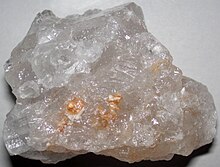
Back Sira ACE Tafelsout AF Speisesalz ALS Sal AN नमक ANP ملح الطعام Arabic ܡܠܚܐ (ܐܨܪܐ) ARC ملحة ARY ملح الاكل ARZ Sal AST

In common usage, salt is a mineral composed primarily of sodium chloride (NaCl). When used in food, especially in granulated form, it is more formally called table salt. In the form of a natural crystalline mineral, salt is also known as rock salt or halite. Salt is essential for life in general (being the source of the essential dietary minerals sodium and chlorine), and saltiness is one of the basic human tastes. Salt is one of the oldest and most ubiquitous food seasonings, and is known to uniformly improve the taste perception of food, including otherwise unpalatable food.[1] Salting, brining, and pickling are ancient and important methods of food preservation.
Some of the earliest evidence of salt processing dates to around 6000 BC, when people living in the area of present-day Romania boiled spring water to extract salts; a salt works in China dates to approximately the same period.[2] Salt was prized by the ancient Hebrews, Greeks, Romans, Byzantines, Hittites, Egyptians, and Indians. Salt became an important article of trade and was transported by boat across the Mediterranean Sea, along specially built salt roads, and across the Sahara on camel caravans. The scarcity and universal need for salt have led nations to go to war over it and use it to raise tax revenues. Salt is used in religious ceremonies and has other cultural and traditional significance.
Salt is processed from salt mines, and by the evaporation of seawater (sea salt) and mineral-rich spring water in shallow pools. The greatest single use for salt (sodium chloride) is as a feedstock for the production of chemicals.[3] It is used to produce caustic soda and chlorine, and in the manufacture of products such as polyvinyl chloride, plastics, and paper pulp. Of the annual global production of around three hundred million tonnes, only a small percentage is used for human consumption. Other uses include water conditioning processes, de-icing highways, and agricultural use. Edible salt is sold in forms such as sea salt and table salt, the latter of which usually contains an anti-caking agent and may be iodised to prevent iodine deficiency. As well as its use in cooking and at the table, salt is present in many processed foods.
Sodium is an essential element for human health via its role as an electrolyte and osmotic solute.[4][5][6] However, excessive salt consumption increases the risk of cardiovascular diseases such as hypertension. Such health effects of salt have long been studied. Accordingly, numerous world health associations and experts in developed countries recommend reducing consumption of popular salty foods.[6][7] The World Health Organization recommends that adults consume less than 2,000 mg of sodium, equivalent to 5 grams of salt, per day.[8][9]
- ^ Institute of Medicine (US) Committee on Strategies to Reduce Sodium Intake (2010). "3 — Taste and Flavor Roles of Sodium in Foods: A Unique Challenge to Reducing Sodium Intake". In Jane E. Henney; Christine L. Taylor; Caitlin S. Boon (eds.). Strategies to Reduce Sodium Intake in the United States. Washington, DC: National Academies Press. ISBN 978-0-309-14806-1. Archived from the original on 9 May 2021. Retrieved 29 October 2022.
- ^ Salt: a world history.
- ^ Westphal et al. (2010).
- ^ Cite error: The named reference
USDA2015was invoked but never defined (see the help page). - ^ Committee on the Consequences of Sodium Reduction in Populations; Food Nutrition, Board; Board on Population Health Public Health Practice; Institute Of, Medicine; Strom, B. L.; Yaktine, A. L.; Oria, M. (2013). Strom, Brian L.; Yaktine, Ann L.; Oria, Maria (eds.). Sodium intake in populations: assessment of evidence. Institute of Medicine of the National Academies. doi:10.17226/18311. ISBN 978-0-309-28295-6. PMID 24851297. Archived from the original on 19 October 2013. Retrieved 17 October 2013.
- ^ a b Cite error: The named reference
CDCwas invoked but never defined (see the help page). - ^ "EFSA provides advice on adverse effects of sodium". European Food Safety Authority. 22 June 2005. Archived from the original on 4 August 2017. Retrieved 9 June 2016.
- ^ "WHO issues new guidance on dietary salt and potassium". WHO. 31 January 2013. Archived from the original on 20 July 2016.
- ^ Delahaye, F. (2012). "Europe PMC". Presse Médicale. 41 (6 Pt 1): 644–649. doi:10.1016/j.lpm.2012.02.035. PMID 22465720. Archived from the original on 7 June 2021. Retrieved 7 June 2021.